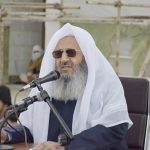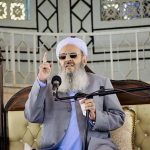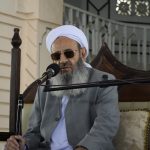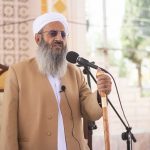 Surrounded by a relatively small Muslim community, Jozef Lenč, a Slovak political science teacher at university, was able to discover his own road towards Islam.
Surrounded by a relatively small Muslim community, Jozef Lenč, a Slovak political science teacher at university, was able to discover his own road towards Islam.
“I’ve found belief by myself,” said Lenč, 34, who converted to Islam when he was 25, told The Slovak Spectator on Monday, October 28.
“When I was visiting my grandmother, I used to go to a Catholic church, but I missed something, especially from the historical point of view. Christian dogmas were accepted later, step by step, with the strong involvement of politics and other interests.”
Finding a book about Islam, Lenč tried to study more about the faith.
“I knew a lot about Islam, I already tried fasting during Ramadan, so it was just a small step to become a Muslim,” said Lenč, mentioning that his family and friends did not have a problem accepting it.
“My mother even stopped cooking pork when I come for lunch.”
After years of finding Islam, Lenč admits that the general opinion of Muslims is largely negative in Slovakia.
“People can’t understand how Islam has freed me,” Lenč said.
“I really don’t have any addictions. I don’t drink.”
In Slovakia, the relatively 4000-5000 Muslim community was basically from immigrants who came to study in the European country in the 1990s and decided to settle.
Mohamad Safwan Hasna, 43, the head of the Islamic Foundation in Slovakia and a translator, first came from Syria in 1991 for study.
“We finished studies here and were not members of General Union of Muslim Students in Slovakia anymore, so we decided to establish a new organization,” he said.
With increasing numbers of Muslims, the community formed the foundation in 1999 to be the first representative for Muslims.
Later in 2009, the Cordoba Centre for Intercultural Dialogue – generally considered to be the central Islamic institution in Slovakia – opened in Bratislava.
The foundation’s activities include common prayers, exhibitions and educational courses about Islam. It publishes a newsletter, hosts programs for children and takes collections for the poor.
Problems
Despite integrating well in the community, Slovak Muslims have complained from the state’s failure to recognize Islam as an official religion.
In 2007, the Slovak parliament changed the law so that at least 20,000 members are required for recognition, making it impossible for a Muslim community of 5,000 people.
“The law has begun to be misused by various speculative organizations,” Ján Podmanický, an MP for the Smer party and one of submitters of the new law, told The Slovak Spectator.
The case was very much different in the neighboring Czech Republic, where just 300 members are enough to constitute a religious community.
There are 34 registered religious communities, as compared to 18 in Slovakia.
Some of these 18 religious communities were automatically registered after the formation of independent Slovakia, but 13 of them would not meet the new rules since they have fewer than 20,000 members, according to the 2011 census.
Podmanický is convinced that since freedom of religion is guaranteed in the constitution, no one can prevent Muslims from practicing their faith.
“But it’s not the role of the Slovak Republic to provide state support and funding of religion which has no mass support of the population and is also not a traditional religion in Slovakia,” Podmanický said.
Hasna is convinced that the law was targeting Muslims.
For them, state recognition can help promote their activities and ensure legal protection.
“We will survive, but it could improve our position in the eyes of Slovaks,” Hasna said.
“I suppose that we are well integrated, so I don’t see the point of this rejection.”
The absence of mosques constituted another problem for Slovakia Muslims who found no place for their prayers and gatherings.
Living in the only European country without a single mosque, officials at the Islamic Foundation have tried to obtain a permit to build a mosque in Bratislava, but had its application rejected.
“It would be nice if there was one mosque in Bratislava,” said Azim Farhadi, a 39-year-old native of Afghanistan.
“It is fine to have three places to pray, but I would prefer unity.”
Inciting Media
Media coverage for Muslims, associating them with terrorists, was also spreading anti-Muslim concerns.
“Older people are not as informed as younger ones; they acquire information mostly from the media,” he said.
“Sometimes it’s a shame what the Slovak media is doing.”
Farhadi has produced a program about the integration of foreigners for Slovak television. He cited his fellow journalists’ choice of the word Islamist to refer to religious extremists.
In the eyes of the public, the word becomes closely associated with Islam itself.
Elena Gallová Kriglerová, director of the Centre for the Research of Ethnicity and Culture (CVEK) in Bratislava, agreed with Farhadi’s criticism of the media.
“The media is creating a sense of fear out of Islam,” she said.
“Usually they don’t do it consciously, but the prejudice of journalists plays a significant role here.”
Conducting several surveys about the opinion of Slovaks on minorities and religions, CVEK found that nearly 70 percent of respondents disapproved of the state allowing Muslims to practice their faith.
Half agreed that Islamic religious and cultural centers in Slovakia should not be permitted.
“People are afraid that if we’ll allow a mosque here, Muslims will start to move here in droves, then they will try to turn us to Islam and they will dominate here,” Kriglerová said.
Kriglerová attributes some of the prejudice to history or strong Christian conservatism.
“One hundred years ago, under the Bratislava Castle, you could find the Catholic St Martin’s Cathedral, a Jewish synagogue, the Orthodox Church and there was a mosque as well – next to each other,” she said.
“Today only Catholic and Orthodox churches remain on that place.”
Source: OnIslam








Comments